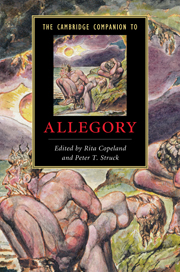Book contents
- Frontmatter
- Introduction
- Part I: Ancient foundations
- Part II: Philosophy, theology, and poetry 200 to 1200
- Part III: Literary allegory: philosophy and figuration
- 8 Allegory in the Roman de la Rose
- 9 Dante and allegory
- 10 Medieval secular allegory: French and English
- 11 Medieval religious allegory: French and English
- 12 Renaissance allegory from Petrarch to Spenser
- 13 Protestant allegory
- 14 Allegorical drama
- Part IV: The fall and rise of allegory
- Further reading
- Index
13 - Protestant allegory
from Part III: - Literary allegory: philosophy and figuration
Published online by Cambridge University Press: 28 January 2011
- Frontmatter
- Introduction
- Part I: Ancient foundations
- Part II: Philosophy, theology, and poetry 200 to 1200
- Part III: Literary allegory: philosophy and figuration
- 8 Allegory in the Roman de la Rose
- 9 Dante and allegory
- 10 Medieval secular allegory: French and English
- 11 Medieval religious allegory: French and English
- 12 Renaissance allegory from Petrarch to Spenser
- 13 Protestant allegory
- 14 Allegorical drama
- Part IV: The fall and rise of allegory
- Further reading
- Index
Summary
Properly speaking, the definitive position on protestant allegory would seem to be that it is a contradiction in terms. Does not the theory of biblical interpretation developed in the early years of the Reformation begin by denying allegory's validity? Certainly, in the hermeneutic works of Martin Luther it is not difficult to find somewhat negative sentiments on allegory: “An interpreter must as much as possible avoid allegory, so that he may not wander in idle dreams.” Again, from a lecture on Genesis: “Allegory is a sort of beautiful harlot, who proves herself especially seductive to idle men” (WA 42.667; LW, 5, 347). Or, most succinctly: “Allegories are empty speculations, and as it were the scum of holy scripture” (WA 42.173.31). The rejection of allegory by Luther appears at first sight to be motivated primarily on theological grounds: it wrests attention away from the words of God, which left to themselves will render forth truth complete and in its own terms. Luther's own mantra, repeated many times, is “The literal sense of scripture alone.” Not only sola scriptura, then, but alongside it an equally significant principle, solus sensus litteralis. Luther does not stand alone in this respect, and the observation is found not only in theology but also in handbooks of rhetoric. Thus Philipp Melanchthon, Luther's junior associate in Wittenberg, wrote in Elementa rhetorices of 1531, what is virtually a manifesto for protestant hermeneutics: Nam oratio quae non habet unam ac simplicem sententiam nihil certi docet (“any discourse which does not have a single and simple meaning teaches nothing for certain”).
- Type
- Chapter
- Information
- The Cambridge Companion to Allegory , pp. 177 - 190Publisher: Cambridge University PressPrint publication year: 2010
- 4
- Cited by



